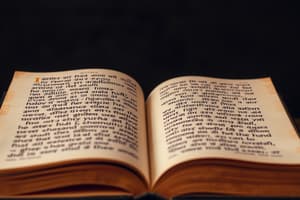Podcast
Questions and Answers
Hindi is a member of the Indo-European language family.
Hindi is a member of the Indo-European language family.
True (A)
The novel 'Chandrakanta' was written by R.K. Narayan.
The novel 'Chandrakanta' was written by R.K. Narayan.
False (B)
Malgudi Days explores the lives of people in a fictional small town in North India.
Malgudi Days explores the lives of people in a fictional small town in North India.
False (B)
Hindi literature includes works in poetic, dramatic, and narrative forms.
Hindi literature includes works in poetic, dramatic, and narrative forms.
The Vedas, the earliest Hindu scriptures, are written in Hindi.
The Vedas, the earliest Hindu scriptures, are written in Hindi.
Arundhati Roy's novel 'The God of Small Things' delves into themes of science fiction.
Arundhati Roy's novel 'The God of Small Things' delves into themes of science fiction.
Surdas was a 15th-century poet who wrote poems in Awadhi, a dialect of Hindi.
Surdas was a 15th-century poet who wrote poems in Awadhi, a dialect of Hindi.
Mirza Ghalib, in addition to Urdu and Persian, also wrote poetry in Hindi.
Mirza Ghalib, in addition to Urdu and Persian, also wrote poetry in Hindi.
Maithili Sharan Gupt is credited with popularizing the use of 'ansh', a poetic form where each line starts with the same word.
Maithili Sharan Gupt is credited with popularizing the use of 'ansh', a poetic form where each line starts with the same word.
Hindi poetry often focuses on themes like love, nature, technology, and social justice.
Hindi poetry often focuses on themes like love, nature, technology, and social justice.
Hindi follows the Subject-Verb-Object (SVO) word order in sentences.
Hindi follows the Subject-Verb-Object (SVO) word order in sentences.
Hindi has four genders: masculine, feminine, neuter, and common.
Hindi has four genders: masculine, feminine, neuter, and common.
Study Notes
Exploring Hindi: Prose, Literature, Poetry, and Language Structure
Hindi, a member of the Indo-Aryan subfamily of the Indo-European language family, is spoken by over 530 million people worldwide, primarily in India and neighboring countries like Nepal and Fiji. With a rich cultural heritage and a complex language structure, Hindi is a fascinating language that has inspired diverse genres of literature.
Prose
Hindi prose is a reflection of both traditional and modern narratives, revealing the evolving nature of the language and society. Hindi novels and short stories often delve into themes such as social issues, family dynamics, and individual identity. Some notable Hindi prose works include:
- "Chandrakanta" by Devaki Nandan Khatri, an 1883 novel that explores the story of a princess with supernatural powers.
- "Malgudi Days" by R. K. Narayan, a series of interconnected short stories set in a fictional small town in South India that offers a glimpse into the lives of ordinary people.
- "The God of Small Things" by Arundhati Roy, a postmodern novel that explores themes of caste, class, and gender in contemporary Kerala.
Literature
Hindi literature, extending over centuries, has produced a wealth of poetic, dramatic, and narrative works. The Vedas, the earliest Hindu scriptures, are written in Sanskrit but have influenced later Hindi literature. Hindi poetry and drama have been shaped by the works of celebrated poets and playwrights like:
- Surdas, a blind 16th-century poet, who wrote poems in Braj Bhasha, a dialect of Hindi, that are considered to be his most significant works.
- Mirza Ghalib, a 19th-century Urdu and Persian poet, who also wrote in Hindi and is known for his mastery of the mournful doha poetic form.
- Maithili Sharan Gupt, a 20th-century poet who popularized the use of the ansh, a poetic form that uses the first letter of each line to form a word or phrase at the end of each line.
Poetry
Hindi poetry is known for its lyrical and emotional quality, showcasing the beauty of the language and the human experience. Hindi poetry often focuses on themes like love, nature, spirituality, and social justice. Poetry forms include:
- Shlokas, verses of four lines that often follow a specific rhyme scheme and are used in religious texts and devotional songs.
- Chaupai, a 22-line poetic form that follows a specific metrical pattern and is often used in Hanuman Chalisa, a popular Hindu devotional poem.
- Doha, a two-line poetic form that often follows a specific rhyme scheme and is used in various genres.
Language Structure
Hindi is an agglutinative language, meaning that words can be combined to form longer words. Hindi has a complex grammar structure, including:
- Gender: Hindi has three genders: masculine, feminine, and neuter.
- Cases: Hindi has six cases: nominative, accusative, dative, instrumental, ablative, and locative.
- Tenses: Hindi has six tenses: present simple, past simple, future simple, present progressive, past progressive, and future progressive.
- Word order: Hindi follows the Subject-Object-Verb (SOV) word order, but word order can be flexible depending on the context.
Grammar
Hindi grammar has several unique features, including:
- Agreement: Hindi has gender-based agreement between adjectives, pronouns, and nouns.
- Conjugation: Hindi verbs are conjugated depending on the person, number, gender, tense, and mood.
- Negative construction: Hindi uses a separate word, "nahin" or "na", to form negative sentences.
In conclusion, Hindi is a complex and beautiful language that offers a wealth of literature, poetry, and prose. Its grammar structure and unique features make it a fascinating language to explore. Whether you're interested in literature, poetry, or language structure, Hindi has something to offer for everyone. So, dive into the world of Hindi and get ready to be amazed by the depth and richness of the language and its literature.
Studying That Suits You
Use AI to generate personalized quizzes and flashcards to suit your learning preferences.
Description
Test your knowledge of Hindi prose, literature, poetry, and language structure with this quiz. Explore the rich cultural heritage, diverse genres of literature, and unique features of the Hindi language.




